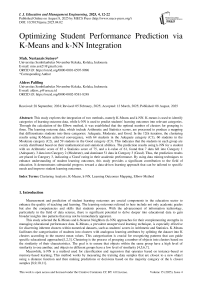Optimizing Student Performance Prediction via K-Means and k-NN Integration
Автор: Muh. Nurtanzis Sutoyo, Alders Paliling
Журнал: International Journal of Education and Management Engineering @ijeme
Статья в выпуске: 4 vol.15, 2025 года.
Бесплатный доступ
This study explores the integration of two methods, namely K-Means and k-NN. K-means is used to identify categories of learning outcome data, while k-NN is used to predict students' learning outcomes into relevant categories. Through the calculation of the Elbow method, it was established that the optimal number of clusters for grouping is three. The learning outcome data, which include Arithmetic and Statistics scores, are processed to produce a mapping that differentiates students into three categories: Adequate, Moderate, and Good. In the 12th iteration, the clustering results using K-Means achieved convergence, with 64 students in the Adequate category (C1), 60 students in the Moderate category (C2), and 59 students in the Good category (C3). This indicates that the students in each group are evenly distributed based on their mathematical and statistical abilities. The prediction results using k-NN for a student with an Arithmetic score of 85 a Statistics score of 75, and a k-value of 61, found that 7 data fell into Category 1 (Adequate), 3 data into Category 2 (Moderate), and dominant 51 data in Category 3 (Good). Thus, the prediction results are placed in Category 3, indicating a 'Good' rating in their academic performance. By using data mining techniques to enhance understanding of student learning outcomes, this study provides a significant contribution to the field of education. It demonstrates substantial progress toward a data-driven learning approach that can be tailored to specific needs and improve student learning outcomes.
Clustering Analysis, K-Means, k-NN, Learning Outcomes Mapping, Elbow Method
Короткий адрес: https://sciup.org/15019875
IDR: 15019875 | DOI: 10.5815/ijeme.2025.04.02


